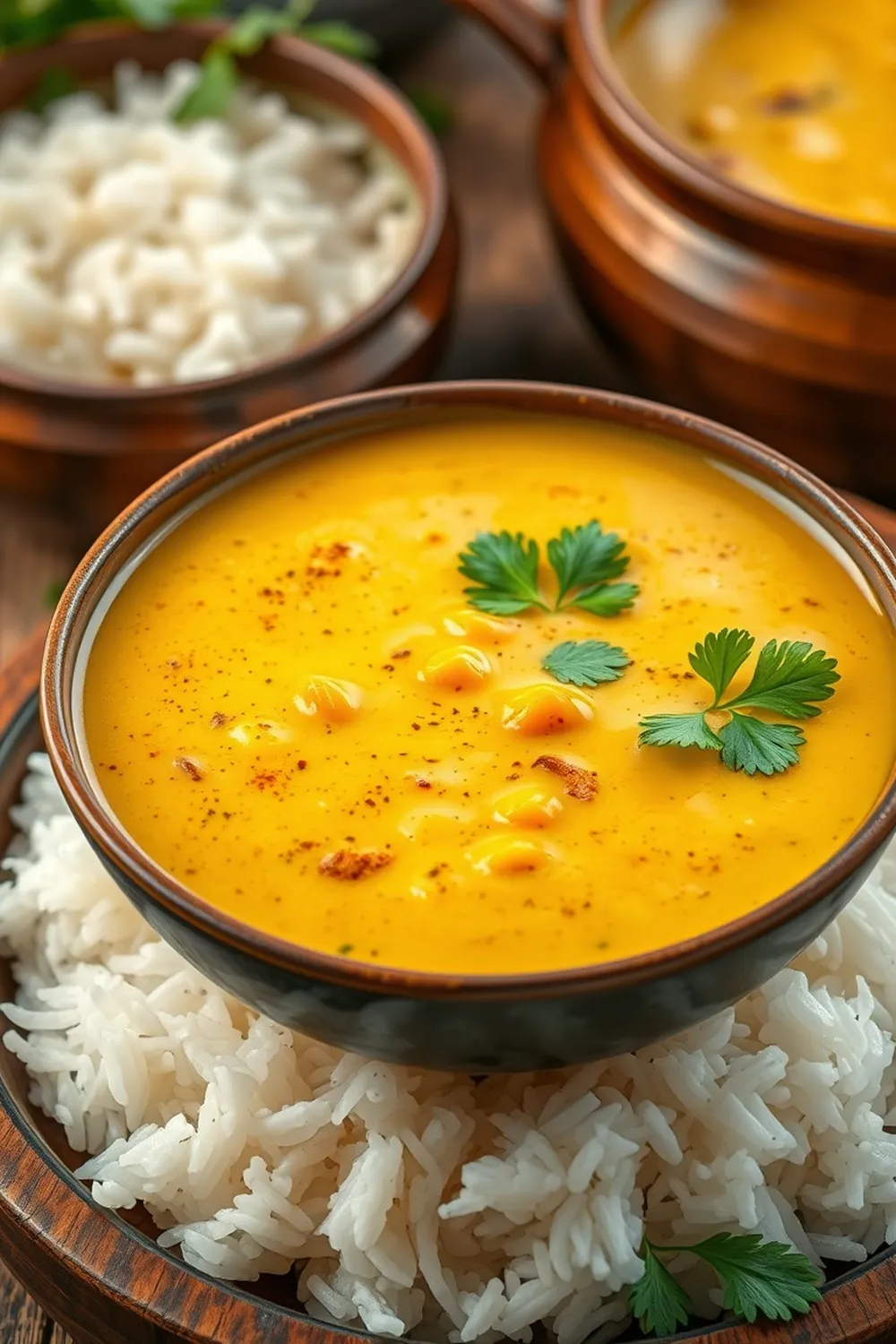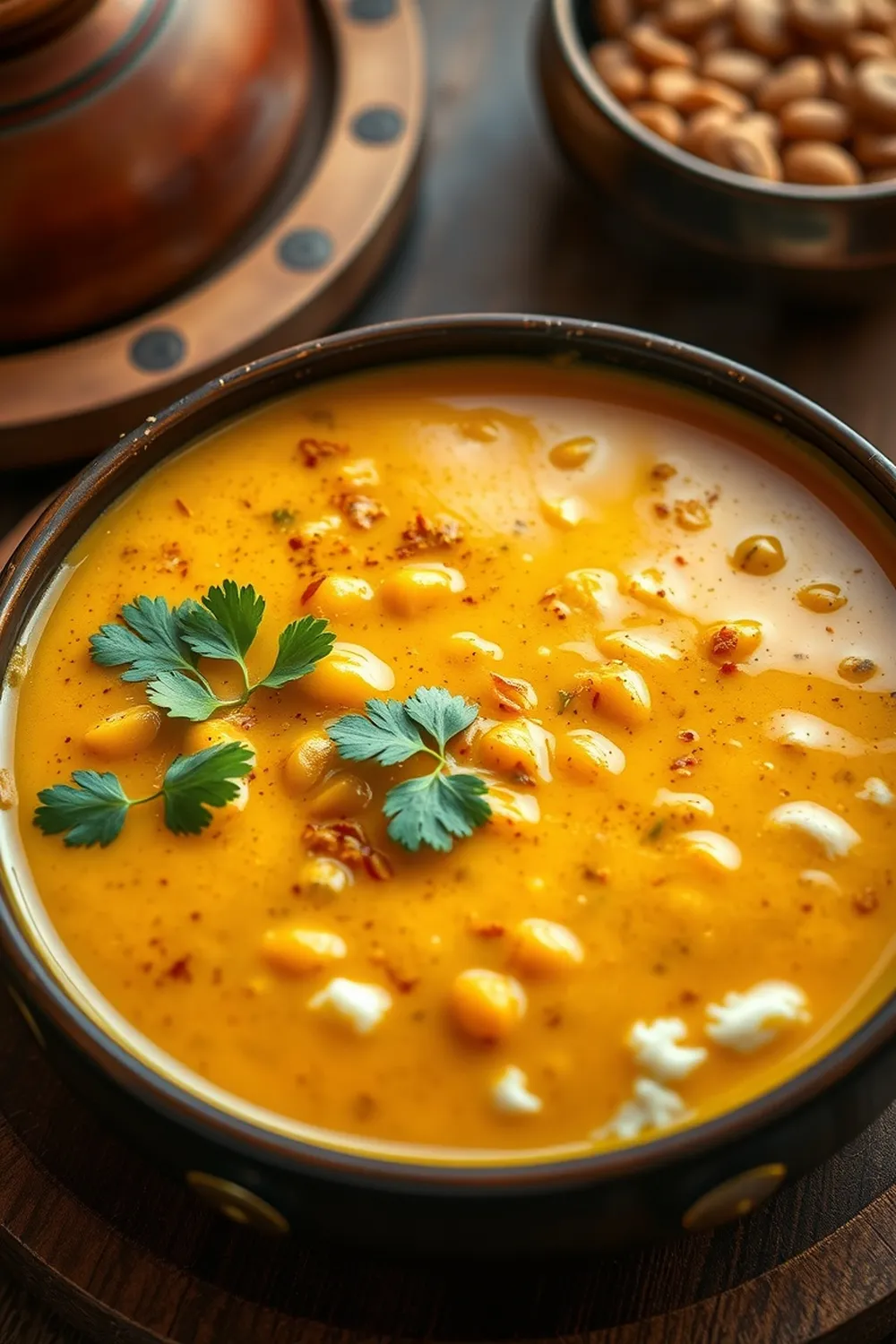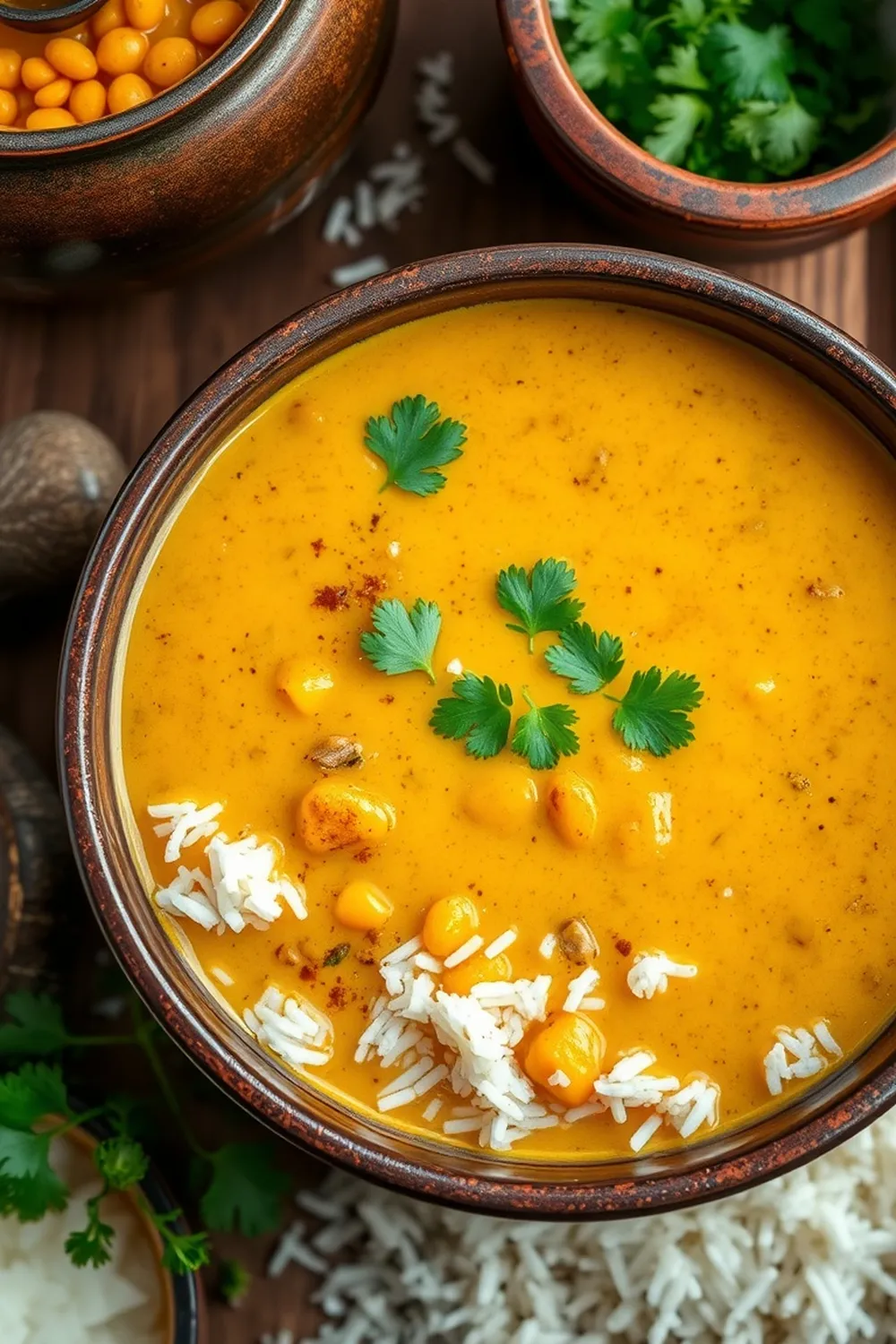- Wash masoor dal thoroughly and drain. Prepare all ingredients.
- Heat butter in Instant Pot (Sauté mode). Add bay leaf, minced garlic, minced ginger, chopped onion, diced potato, and crushed coriander. Sauté for 2-3 minutes, or until onions are translucent.
- Cancel Sauté mode. Add all spice powders and mix well, sautéing for 30 seconds to bloom the spices.
- Add drained masoor dal, chopped coriander leaves, and 4 cups of water. Pressure cook on High for 8 minutes (or 3-4 whistles in a stovetop cooker).
- Allow for a natural pressure release for 10 minutes, then quick-release any remaining pressure. Remove bay leaf. Add salt to taste.
- Blend soup until smooth using an immersion blender. If the soup is too thick, add a little more water.
- Return to Sauté mode. Add coconut milk, mix well, and simmer for 2-3 minutes. Adjust salt to taste.
- Stir in lemon juice. Serve hot over cooked basmati rice, garnished with fresh coriander leaves.
- Calories:220 kcal25%
- Energy:920 kJ22%
- Protein:9 g28%
- Carbohydrates:30 mg40%
- Sugar:3 mg8%
- Salt:300 g25%
- Fat:8 g20%
Last Updated on 2 months by Neha Deshmukh
Masoor Dal Soup Recipe – Coconut Milk & Red Lentil Delight
Introduction
There’s just something so comforting about a warm bowl of soup, isn’t there? Especially when it’s packed with flavour and goodness! I stumbled upon this Masoor Dal Soup a few years ago, looking for a way to use up some red lentils, and it quickly became a family favourite. It’s creamy, subtly spiced, and incredibly easy to make – perfect for a weeknight dinner or a cozy weekend lunch. This isn’t your average dal; the coconut milk adds a beautiful richness, and the blend of spices is just divine. Let’s get cooking!
Why You’ll Love This Recipe
This Masoor Dal Soup is a winner for so many reasons! It’s quick – ready in under 30 minutes. It’s healthy, brimming with protein and fibre from the red lentils. And it’s unbelievably flavourful, offering a delightful blend of Indian spices in a creamy, comforting base. Plus, it’s easily adaptable to suit your preferences – more on that later!
Ingredients
Here’s what you’ll need to create this delicious soup:
- 1 cup Masoor Dal (Red Lentils)
- 1 cup Coconut Milk
- 1 cup Cooked Basmati Rice (for serving)
- 1 Onion, medium, chopped
- 1 tablespoon Garlic cloves, minced
- 1 tablespoon Ginger, grated
- 2 teaspoons Lemon juice
- 3-4 tablespoons Coriander leaves, chopped (plus extra for garnish)
- 1 tablespoon Butter
- 1 Biryani leaf (Indian bay leaf)
- 1 teaspoon Black pepper powder
- 1 teaspoon Cumin seeds powder
- 1 tablespoon Sambar powder or Curry powder
- 1 teaspoon Garam masala powder
- 1 teaspoon Turmeric powder
Ingredient Notes
Let’s talk ingredients! A few little tips can make all the difference.
Masoor Dal (Red Lentils): Benefits & Selection
Masoor dal is a fantastic source of protein, fibre, and iron. It cooks quickly and doesn’t require pre-soaking, which is a huge win for busy cooks like me! Look for lentils that are vibrant red and free from any debris. 1 cup of masoor dal is approximately 200g.
Coconut Milk: Full-Fat vs. Light & Regional Variations
I prefer full-fat coconut milk for the richest flavour and creamiest texture. However, light coconut milk works well if you’re watching your calorie intake. You can also experiment with different regional varieties of coconut milk – Thai coconut milk tends to be sweeter, while Indian coconut milk is often more subtle. 1 cup is roughly 240ml.
Spices: Exploring Sambar Powder & Garam Masala
These spices are the heart and soul of this soup! Sambar powder adds a lovely tangy, savoury flavour. Garam masala is a warming blend of spices that ties everything together. Don’t be afraid to adjust the amounts to your liking.
Butter: Ghee as a Traditional Substitute
Butter adds a lovely richness, but for a truly authentic flavour, consider using ghee (clarified butter). Ghee has a nutty aroma and a higher smoke point, making it ideal for Indian cooking.
Biryani Leaf (Indian Bay Leaf): Aromatic Significance
Biryani leaf, also known as Indian bay leaf, has a distinct aroma that adds depth to the soup. Don’t skip it if you can find it! It’s different from regular bay leaves, so try to source the Indian variety.
Step-By-Step Instructions
Alright, let’s get cooking!
- First, give the masoor dal a good wash under cold water and drain it well. This helps remove any impurities.
- Now, heat the butter in your Instant Pot (using the Saute mode). If you don’t have an Instant Pot, a large pot on the stovetop works perfectly too! Add the biryani leaf, minced garlic, grated ginger, chopped onion, and diced potato. Sauté for about 2 minutes, until the onions are softened.
- Cancel the Saute mode. Add the black pepper powder, cumin seeds powder, sambar powder (or curry powder), and turmeric powder. Mix well to coat the vegetables with the spices. The aroma at this stage is incredible!
- Add the drained masoor dal, chopped coriander leaves, and 1.5 cups (360ml) of water. If using an Instant Pot, pressure cook on High for 5 minutes. If using a stovetop pressure cooker, cook for 3 whistles.
- Carefully quick-release the pressure (or let it release naturally). Remove the biryani leaf. Add another 1.5 cups (360ml) of water and salt to taste. Now, using an immersion blender, blend the soup until it’s beautifully smooth.
- Return the Instant Pot to Saute mode (or use your stovetop pot over medium heat). Add the coconut milk and mix well. Simmer for a few minutes, allowing the flavours to meld. Adjust the salt as needed.
- Finally, stir in the lemon juice. Serve hot over cooked basmati rice, garnished with fresh coriander leaves. Enjoy!
Expert Tips
A few little secrets to make your soup even better!
Achieving the Perfect Soup Consistency
If you prefer a thicker soup, use less water. For a thinner soup, add more. It’s all about personal preference!
Balancing Spice Levels
Start with the recommended amount of spices and taste as you go. You can always add more, but you can’t take it away!
Using an Immersion Blender vs. Traditional Blender
An immersion blender is super convenient for blending soups directly in the pot. However, a traditional blender works just as well – just be careful when blending hot liquids! Blend in batches and vent the lid to prevent pressure buildup.
Variations
Let’s get creative!
Vegan Masoor Dal Soup
Simply substitute the butter with a plant-based oil like coconut oil or olive oil.
Gluten-Free Adaptation
This recipe is naturally gluten-free! Just double-check that your sambar powder or curry powder doesn’t contain any gluten-containing ingredients.
Adjusting Spice Level (Mild, Medium, Hot)
- Mild: Reduce the amount of sambar powder/curry powder to ½ tablespoon.
- Medium: Use the recipe as written.
- Hot: Add a pinch of cayenne pepper or a finely chopped green chilli along with the other spices.
Festival Adaptations (Navratri, Diwali)
During Navratri, you can skip the onion and garlic for a satvik (pure) version. For Diwali, a little extra ghee and a sprinkle of chopped nuts make it extra festive!
Serving Suggestions
This soup is fantastic on its own, but here are a few ideas to elevate your meal:
- Serve with a side of warm naan or roti.
- Add a dollop of plain yogurt or vegan yogurt for extra creaminess.
- Garnish with a sprinkle of toasted cumin seeds.
Storage Instructions
Leftover soup can be stored in an airtight container in the refrigerator for up to 3 days. It also freezes well – just thaw it overnight in the refrigerator before reheating.
FAQs
Got questions? I’ve got answers!
What is Masoor Dal and is it healthy?
Masoor dal, or red lentils, is a type of lentil that’s widely used in Indian cuisine. It’s incredibly healthy, packed with protein, fibre, iron, and folate.
Can I make this soup ahead of time?
Absolutely! You can make the soup a day or two in advance and store it in the refrigerator. The flavours will actually develop even more over time.
What can I substitute for coconut milk?
If you don’t have coconut milk, you can use heavy cream or cashew cream as a substitute. However, the flavour will be different.
Can I use a stovetop pressure cooker instead of an Instant Pot?
Yes, definitely! Just cook for 3 whistles on medium heat.
How can I adjust the thickness of the soup?
Add more water for a thinner soup, or less water for a thicker soup. You can also add a tablespoon of cornstarch mixed with water to thicken it up.
Is Sambar powder different from Curry powder?
Yes, they are! Sambar powder is a South Indian spice blend with a tangy, savoury flavour. Curry powder is a more general blend of spices, often used in North Indian and Western cuisine. They aren’t interchangeable, but sambar powder is a delicious addition to this soup!










